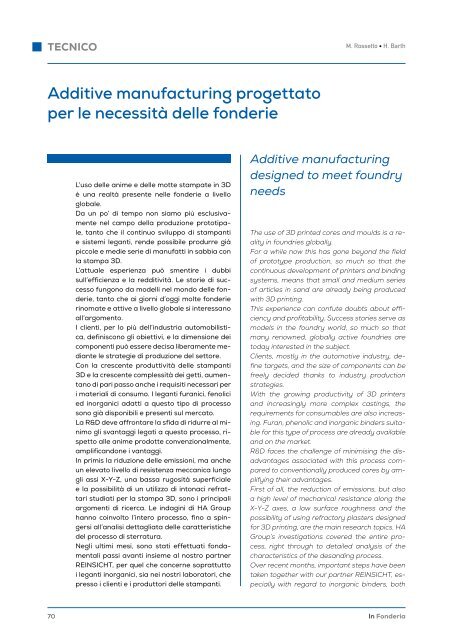In Fonderia 1 2024
Primo numero del 2024 di In Fonderia
Primo numero del 2024 di In Fonderia
Create successful ePaper yourself
Turn your PDF publications into a flip-book with our unique Google optimized e-Paper software.
TECNICO<br />
M. Rossetto • H. Barth<br />
Additive manufacturing progettato<br />
per le necessità delle fonderie<br />
L’uso delle anime e delle motte stampate in 3D<br />
è una realtà presente nelle fonderie a livello<br />
globale.<br />
Da un po’ di tempo non siamo più esclusivamente<br />
nel campo della produzione prototipale,<br />
tanto che il continuo sviluppo di stampanti<br />
e sistemi leganti, rende possibile produrre già<br />
piccole e medie serie di manufatti in sabbia con<br />
la stampa 3D.<br />
L’attuale esperienza può smentire i dubbi<br />
sull’efficienza e la redditività. Le storie di successo<br />
fungono da modelli nel mondo delle fonderie,<br />
tanto che ai giorni d’oggi molte fonderie<br />
rinomate e attive a livello globale si interessano<br />
all’argomento.<br />
I clienti, per lo più dell’industria automobilistica,<br />
definiscono gli obiettivi, e la dimensione dei<br />
componenti può essere decisa liberamente mediante<br />
le strategie di produzione del settore.<br />
Con la crescente produttività delle stampanti<br />
3D e la crescente complessità dei getti, aumentano<br />
di pari passo anche i requisiti necessari per<br />
i materiali di consumo. I leganti furanici, fenolici<br />
ed inorganici adatti a questo tipo di processo<br />
sono già disponibili e presenti sul mercato.<br />
La R&D deve affrontare la sfida di ridurre al minimo<br />
gli svantaggi legati a questo processo, rispetto<br />
alle anime prodotte convenzionalmente,<br />
amplificandone i vantaggi.<br />
<strong>In</strong> primis la riduzione delle emissioni, ma anche<br />
un elevato livello di resistenza meccanica lungo<br />
gli assi X-Y-Z, una bassa rugosità superficiale<br />
e la possibilità di un utilizzo di intonaci refrattari<br />
studiati per la stampa 3D, sono i principali<br />
argomenti di ricerca. Le indagini di HA Group<br />
hanno coinvolto l’intero processo, fino a spingersi<br />
all’analisi dettagliata delle caratteristiche<br />
del processo di sterratura.<br />
Negli ultimi mesi, sono stati effettuati fondamentali<br />
passi avanti insieme al nostro partner<br />
REINSICHT, per quel che concerne soprattutto<br />
i leganti inorganici, sia nei nostri laboratori, che<br />
presso i clienti e i produttori delle stampanti.<br />
Additive manufacturing<br />
designed to meet foundry<br />
needs<br />
The use of 3D printed cores and moulds is a reality<br />
in foundries globally.<br />
For a while now this has gone beyond the field<br />
of prototype production, so much so that the<br />
continuous development of printers and binding<br />
systems, means that small and medium series<br />
of articles in sand are already being produced<br />
with 3D printing.<br />
This experience can confute doubts about efficiency<br />
and profitability. Success stories serve as<br />
models in the foundry world, so much so that<br />
many renowned, globally active foundries are<br />
today interested in the subject.<br />
Clients, mostly in the automotive industry, define<br />
targets, and the size of components can be<br />
freely decided thanks to industry production<br />
strategies.<br />
With the growing productivity of 3D printers<br />
and increasingly more complex castings, the<br />
requirements for consumables are also increasing.<br />
Furan, phenolic and inorganic binders suitable<br />
for this type of process are already available<br />
and on the market.<br />
R&D faces the challenge of minimising the disadvantages<br />
associated with this process compared<br />
to conventionally produced cores by amplifying<br />
their advantages.<br />
First of all, the reduction of emissions, but also<br />
a high level of mechanical resistance along the<br />
X-Y-Z axes, a low surface roughness and the<br />
possibility of using refractory plasters designed<br />
for 3D printing, are the main research topics. HA<br />
Group’s investigations covered the entire process,<br />
right through to detailed analysis of the<br />
characteristics of the desanding process.<br />
Over recent months, important steps have been<br />
taken together with our partner REINSICHT, especially<br />
with regard to inorganic binders, both<br />
70 <strong>In</strong> <strong>Fonderia</strong>














